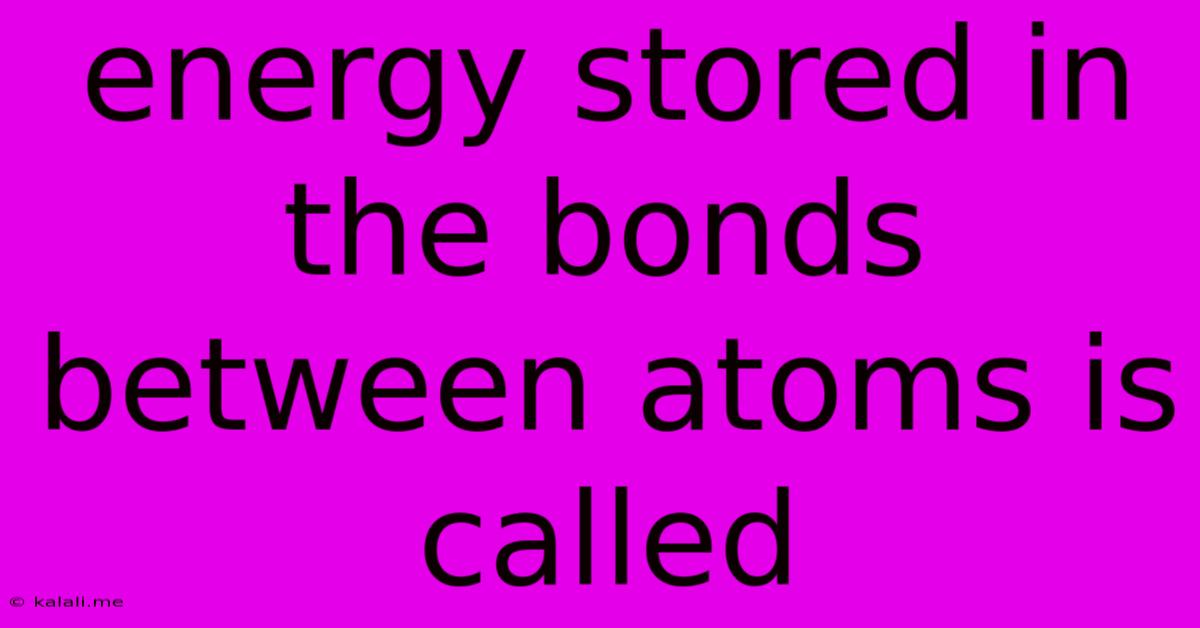Energy Stored In The Bonds Between Atoms Is Called
Kalali
Jun 14, 2025 · 3 min read

Table of Contents
Energy Stored in the Bonds Between Atoms is Called Chemical Energy
The energy stored in the bonds between atoms is called chemical energy. This energy is a form of potential energy, meaning it's stored energy that has the potential to be converted into other forms of energy, like kinetic energy (movement) or heat. Understanding chemical energy is fundamental to comprehending a vast range of natural processes and technological applications, from the digestion of food to the operation of batteries.
This article will delve into the nature of chemical energy, exploring its origins, how it's stored, and its various applications. We'll also touch upon related concepts like bond energy, enthalpy, and the role of chemical reactions in releasing this stored potential.
What is Chemical Energy?
At its core, chemical energy is the potential energy held within the structural arrangement of atoms within molecules. The strength of the bonds between these atoms dictates the amount of chemical energy present. Stronger bonds hold more energy, while weaker bonds hold less. This energy is released or absorbed during chemical reactions, where bonds are broken and reformed. Think of it like a compressed spring; the tighter the compression, the more potential energy is stored, ready to be unleashed when the spring is released. Similarly, the tighter the bonds between atoms, the more chemical energy is stored, ready to be released during a chemical reaction.
How is Chemical Energy Stored?
Chemical energy is stored in the electromagnetic forces that hold atoms together in molecules. These forces are primarily due to the interactions between electrons in the outermost shells of the atoms. When atoms form bonds, they achieve a more stable electronic configuration, releasing energy in the process. This released energy is then stored within the newly formed chemical bonds as potential energy. The type of bond (ionic, covalent, or metallic) significantly influences the amount of energy stored.
Examples of Chemical Energy in Action
Chemical energy is ubiquitous in our daily lives, powering numerous processes:
- Combustion: Burning fuel, whether wood, gasoline, or natural gas, involves the rapid release of chemical energy through oxidation reactions. This release is manifested as heat and light.
- Digestion: The process of breaking down food molecules in our bodies involves releasing chemical energy stored in the food's bonds. This energy is then used to fuel our bodily functions.
- Batteries: Batteries store chemical energy that is converted into electrical energy when the battery is in use. The chemical reactions within the battery cause a flow of electrons, producing an electric current.
- Photosynthesis: Plants utilize sunlight to convert carbon dioxide and water into glucose (sugar), storing chemical energy in the glucose molecules. This process is the foundation of most food chains.
- Explosions: Explosions are characterized by the extremely rapid release of chemical energy, often accompanied by a large volume expansion and a shockwave.
Bond Energy and Enthalpy
Bond energy refers to the amount of energy required to break a specific chemical bond. Higher bond energies indicate stronger bonds and therefore more stored chemical energy. Enthalpy (often represented as ΔH) is a thermodynamic quantity that describes the heat content of a system at constant pressure. Changes in enthalpy (ΔH) during chemical reactions indicate whether energy is released (exothermic, ΔH < 0) or absorbed (endothermic, ΔH > 0).
Conclusion
Chemical energy, the potential energy stored within the bonds of molecules, is fundamental to countless natural phenomena and technological advancements. Understanding how this energy is stored and released is crucial in various scientific disciplines, from chemistry and biology to engineering and materials science. By breaking down complex chemical interactions into simpler terms, we can better appreciate the pivotal role of chemical energy in the world around us. Further research into harnessing and efficiently utilizing chemical energy remains a significant area of ongoing scientific exploration.
Latest Posts
Latest Posts
-
Biuret Reagent Is Used To Test For The Presence Of
Jun 15, 2025
-
Which Of The Following Compounds Contains Ionic Bonds
Jun 15, 2025
-
Which Of The Following Is True Of Viruses
Jun 15, 2025
-
Which One Of The Following Processes Is Exothermic
Jun 15, 2025
-
A Horizontal Row On The Periodic Table Is Called
Jun 15, 2025
Related Post
Thank you for visiting our website which covers about Energy Stored In The Bonds Between Atoms Is Called . We hope the information provided has been useful to you. Feel free to contact us if you have any questions or need further assistance. See you next time and don't miss to bookmark.